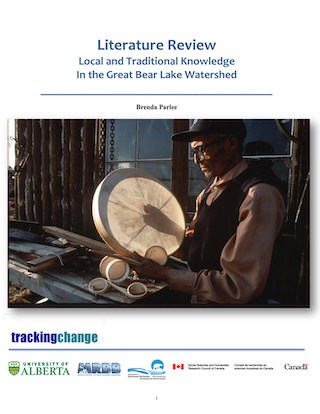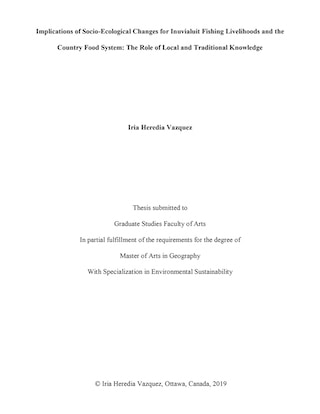About Great Bear Lake
“Great Bear Lake is the second deepest lake in Canada behind Great Slave Lake. The name Great Bear Lake is thought to have originated from ‘Sa tue dene’ meaning ‘grizzly bear water people (Parlee, 2019: 8). Overall, however, the Mackenzie-Great Bear sub-basin is the largest of the six Mackenzie sub-basins (Mackenzie River Basin Board, 2003: 169). This sub-basin has approximately 7,800 people and thirteen communities, with Inuvik being the largest community at 2,900 people (Mackenzie River Basin Board, 2003: 169). The Great Bear Lake is one of Canada’s most magnificent geographic features.
“The Great Bear Lake Watershed is home to the Sahtú Dene communities of Fort Good Hope, Délįne, Tulita, and Colville Lake and is also an area historically used by other Indigenous peoples including the Tłı̨chǫ and Inuit communities of the Kitikmeot region” (Parlee, 2019: 3). Indigenous peoples along the Great Bear Lake have a strong connection and relationship to the region, as well as extensive traditional knowledge. “The historic value of resources of this region were documented through the Sahtú and Metis Comprehensive Land Claim Agreement. The Inuvialuit, Kitikmeot Inuit as well as Tłı̨chǫ communities also have historically used the region from time to time” (Parlee, 2019:8).
“Compared to other regions of the Mackenzie River Basin, there is a relatively significant body of knowledge documented and publicly available for this region and fewer gaps. The key areas of local and traditional knowledge that have been documented have been in the area of oral histories, place names, as well as details about fishing culture, practices, and socio-economic patterns of fishing across the region. Detailed documentation of sites of cultural value was carried out by the Sahtú Heritage Places and Sites Joint Working Group, and others” (Parlee, 2019: 3).
Quick Facts
- Size: 7,800 km2.
- Human Population: The Great Bear Lake is home to the Sahtú people. Around 800 people total, with the Délı̨nę people on the far side of the Great Bear River.
- Jurisdictions: Northwest Territories.
- Ecology: Boreal and Tundra, lakes, tributaries, Canadian shield, interior plains, and pre-glacial valleys.
Community Research Projects
- Chelsea Martin. (2017). The Importance of Traditional Knowledge for Maintaining Fishing Livelihoods During Times of Change in the Sahtú Region.
- Iria Heredia. (2017). Understanding Socio-Ecological Changes in Inuvialuit Fishing Livelihoods and Implications for Food Security: The Role of Local and Traditional Knowledge.
- Great Bear Lake, Dr. Brenda Parlee “Local and Traditional Knowledge in the Great Bear Lake Watershed.”
- 2 Graduate Students – Chelsea Marten, Iria Heredia (Peel/GBL/Mackenzie).
- Sahtú hé Deocha hé Dene Náowerǝ́ Chets’elǝ – Great Bear Lake and Mackenzie River Dene Knowledge: Research Camps 2016 – Leon Andrew, Michael Neyelle, Edward Reeves, Roger Odgard, Jennie Vandermeer, Mandy Bayha, Chelsea Martin.
- Tulit’a Got’ine Traditional Knowledge: The Impact of Climate Change on Fishing Livelihoods – Deborah Simmons.
- Keeping the K’áhsho Got’ı̨nę Fishing Livelihood Strong for the Future – Deborah Simmons.
LEARNING FROM THE LAND
The various bands of Hare Indians occupied, and hunted in, areas to the north of Great Bear Lake; the Mountain, or Slave, the area around Great Bear River; the Dogrib the area between Great Bear Lake and Great Slave Lake; and the Copper in the vicinity of the Deese and McTavish Arms. Hunters regularly made trips to the north shore of the lake, but they and the Indians deemed it prudent to avoid mutual contacts (Stefansson in Johnson 1975:235).
Johnson, L. (1975). The Great Bear Lake: its place in history. Arctic 28(4): 231-244.
Fishing success was often a matter of life or death to early explorers and fur traders in the north. Preble 1908 wrote, “so important are the whitefish as an article of diet that the sites of many, perhaps the majority, of the trading posts, as well as the wintering stations of a number of exploring expeditions—places which have been famous in the Arctic literature—have been selected with a view to the local abundance of fish (Sims 1974).
Sims, C. (1974). Fishing and the Distribution of Aboriginal Peoples in the Boreal Forest. Unpublished manuscript.
Dad used to tell us stories of people along the Dehcho (Mackenzie River) in summer. This was before my time. Some people only came to trading posts to sell their furs and moved back to their chosen camp along the river. Usually, the camps would be in a good fishing place. People would stay there for the summer making dry fish (Jonas Neyelle in Auld and Kershaw 2005:49).
Auld, J. and R. Kershaw (2005). The Sahtú Atlas. Yellowknife: The Sahtú Land Use Planning Board. Friesens. Norman Wells Historical Society Download
Related Publications
- Local and Traditional Knowledge In The Great Bear Lake Watershed
- Air, Land and Water Planning in the Mackenzie
Co-Investigators
Brenda Parlee
Arn Keeling
Bruno Wichmann
Dave Natcher
Henry Huntington
Herman Michell
Jennifer Fresque-Baxter
Mark Nuttall
Shalene Jobin
Sonia Wesche
Trevor Lantz
Val Napoleon
Master Students
Laura Gaitan
M.A. Candidate, Geography


